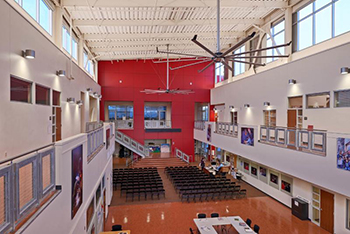La Escuelita Education Center Earns CHPS Verification
 OAKLAND, Calif. — La Escuelita Education Center, which opened in fall 2012 in Oakland, recently received the Collaborative for High Performance Schools (CHPS) verification, California’s highest distinction for sustainable schools. The center is an inner city, mixed-use learning environment, which includes a K-5 elementary school, a program-based high school, a child development center, a studio for KDOL TV Station and a community health clinic.
OAKLAND, Calif. — La Escuelita Education Center, which opened in fall 2012 in Oakland, recently received the Collaborative for High Performance Schools (CHPS) verification, California’s highest distinction for sustainable schools. The center is an inner city, mixed-use learning environment, which includes a K-5 elementary school, a program-based high school, a child development center, a studio for KDOL TV Station and a community health clinic.
Designed by locally based SVA Architects, the center received a 56-point rating, making it one of the highest scoring CHPS-verified projects in the state. School Construction News spoke with Christopher Bradley, AIA, CSI, CCCA, architect, associate partner with SVA Architects, about designing the zero net energy campus and how its new technologies create a learning tool for students.
Q: What was the main goal of the project?
Bradley: The main goal was to replace an existing, multi-school campus at the end of its useable life cycle with a new, low-maintenance and highly sustainable campus that would serve as a blueprint for future campuses within the district.
Q: What were some of the key design elements involved in the project?
Bradley: Net zero certainly drove the design; it’s a zero net energy campus. In general, the project was intended to be one of the most environmentally sustainable school projects in all of California. As it stands today, it is the highest scoring CHPS project in California. Dozens of elements needed to come together: photovoltaics, site selection and the cool towers, among many others. These are all “high visibility” technologies. Additionally, the use of the cool towers is a very innovative use of the technology.
Q: What are some of the key technologies involved?
Bradley: The cool towers are perhaps the most innovative and exciting part of the sustainable systems. Each tower has a large scoop orientated toward prevailing winds. On warmer days, the towers capture the outside air and cool it using a low-energy atomizing fog system. The air, heavier with the water, then descends to the bottom of the tower and is drawn into the occupied spaces and circulated using large, 30-foot diameter fans.
Q: How do these technologies advance the idea of 21st century learning?
Bradley: These technologies are very visible, and as such, are part of the curriculum and the students’ day-to-day life at the school. There is an interactive touch-screen dashboard that helps the students monitor energy usage throughout the day. We believe that low energy campuses are the future of school construction. This is a cutting-edge demonstration of what is possible moving forward.
Q: How were the students and staff involved in the project?
Bradley: The community involvement was exceptional. The multilingual process started within the community to inquire what goals and needs they had of the campus. Once the community input was generated, the process then moved to the superintendent and teacher level for their input. All of the input and research was carefully mapped to create a truly leading-edge facility for learning.
